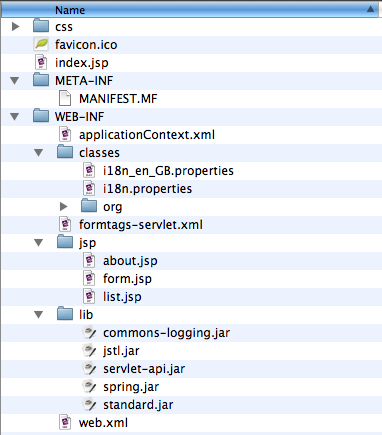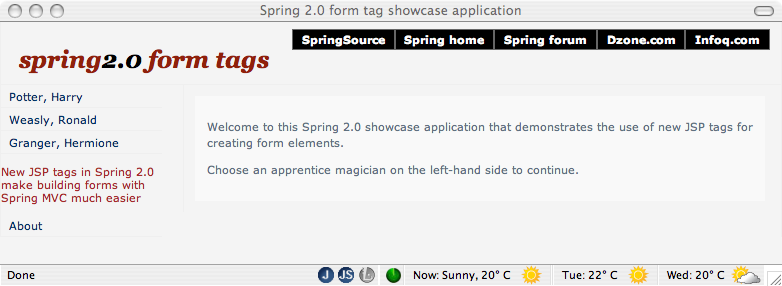We begin with a standard WAR deployment.
![[Note]](images/note.gif) | Note |
|---|---|
| The SpringSource dm Server supports the standard Java EE WAR packaging and deployment format as a first-class citizen, and there are many benefits to deploying a standard WAR file on the dm Server including, but not limited to: tooling support, runtime error diagnostics, FFDC (first failure data capture), etc. In addition, support for standard WAR deployment provides an easy on-ramp for trying out the SpringSource dm Server with existing web applications. |
The following screen shot displays the directory structure of the
Form Tags application using the standard WAR format. As you can see,
there is no deviation from the standard structure and layout, and as
you would expect, all of the web application’s third-party dependencies
(for example, Spring. Commons Logging) are packaged as JARs in
WEB-INF/lib.

To deploy this application, simply copy dist/formtags-war-2.0.0.*.war to
the SERVER_HOME/pickup directory for hot deployment.
You should then see the dm Server produce console output similar to the following:
![[Note]](images/note.gif) | Note |
|---|---|
The console output has been reformatted to fit this document. |
[2009-07-01 14:54:45.135] fs-watcher
<SPDE0048I> Processing 'CREATED' event for file 'formtags-war-2.0.0.RELEASE.war'.
[2009-07-01 14:54:45.797] fs-watcher
<SPDE0010I> Deployment of 'formtags-war-2.0.0.RELEASE.war' version '0' completed.
[2009-07-01 14:54:45.797] Thread-20
<SPWE0000I> Starting web bundle '/formtags-war-2.0.0.RELEASE'.
[2009-07-01 14:54:46.380] Thread-20
<SPWE0001I> Started web bundle '/formtags-war-2.0.0.RELEASE'.
Navigate to http://localhost:8080/ plus the web application context path,
which in the above case is
formtags-war-2.0.0.RELEASE. Thus navigating to
http://localhost:8080/formtags-war-2.0.0.RELEASE
should render the sample application’s welcome page, as displayed in the screen
shot below.
![[Tip]](images/tip.gif) | Tip |
|---|---|
For WARs, the default web context path is the name of the WAR file
without the .war extension. You can optionally
specify a context path using the Web-ContextPath bundle
manifest header, which will be described in further detail later.
|
